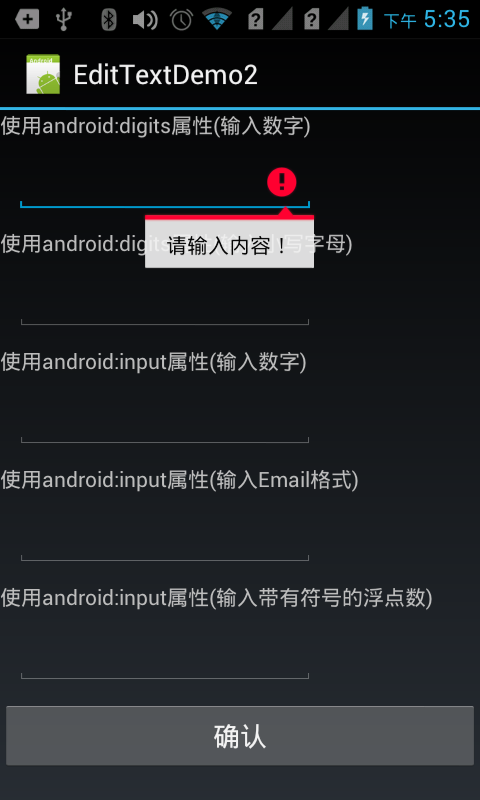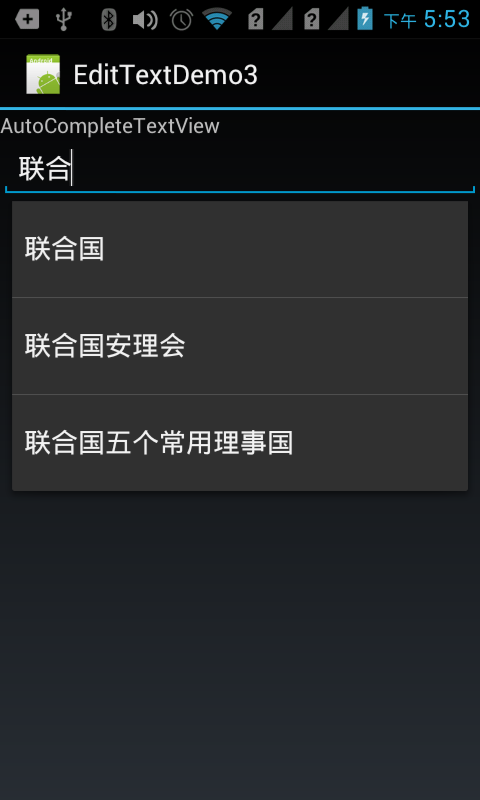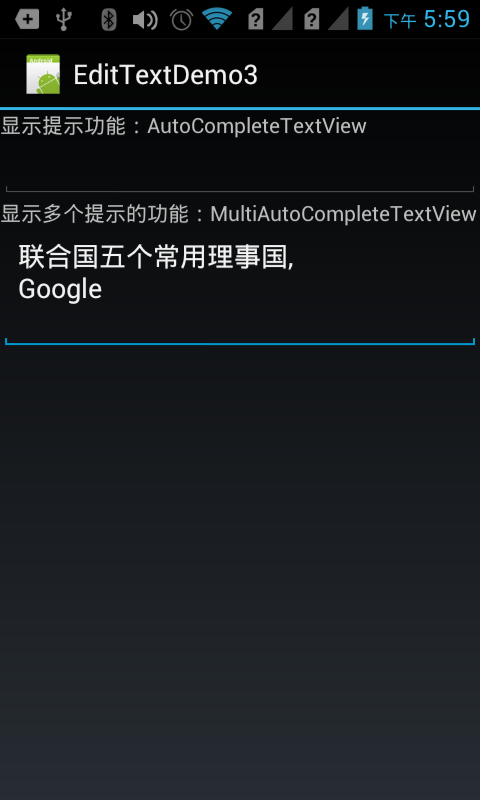Android中EditText控件的几种使用方法
2017-04-08 10:00
615 查看
转自: http://blog.csdn href="http://lib.csdn.net/base/dotnet" target=_blank>.NET /ahuier/article/details/8982516
EditText是除了TextView控件之外的属性,还可以实现输入文本内容。下面我们就举几个实例来练习一下这种控件的使用方法。
1. 案例一:像QQ一样输入表情图像
主要代码:
[java] view
plaincopy
/** Called when the activity is first created. */
@Override
public void onCreate(Bundle savedInstanceState) {
super.onCreate(savedInstanceState);
setContentView(R.layout.main);
initComponent();
button.setOnClickListener(new View.OnClickListener() {
@Override
public void onClick(View v) {
int randomId = 1 + new Random().nextInt(5); //取得随机数randomId 范围在[1,6)之间
try {
//利用反射机制:根据随机产生的1至5的整数从R.drawable类中获得相应资源ID(静态变量)的Field对象
Field field = R.drawable.class.getDeclaredField("face" + randomId); //取得图片的名称+1个随机数
//获得资源ID的值,也就是静态变量的值
int resourceId = Integer.parseInt(field.get(null).toString());
/*
* 在android重要要显示图片信息,必须使用Bitmap位图的对象来装载。
* 查看Android 的BitmapFactory的API文档:Public Methods,这些方法描述了如何讲一些字符串,字节数组转化为字节对象
*/
Bitmap bitmap = BitmapFactory.decodeResource(getResources(), resourceId);
// 要让图片替代指定的文字就要用ImageSpan
ImageSpan imageSpan = new ImageSpan(EditTextDemoActivity.this, bitmap);
// 创建一个SpannableString对象,以便插入用ImageSpan对象封装的图像
SpannableString spannableString = new SpannableString("face");
// 用ImageSpan对象替换face
spannableString.setSpan(imageSpan, 0, 4, Spannable.SPAN_EXCLUSIVE_EXCLUSIVE);
// 将随机获得的图像追加到EditText控件的最后
editText.append(spannableString);
} catch (Exception e) {
// TODO: handle exception
}
}
});
}
Demo执行结果:

2. 案例二:在EditText中输入特定的字符,实现校验功能。
主要代码:
[java] view
plaincopy
button.setOnClickListener(new View.OnClickListener() {
@Override
public void onClick(View v) {
String value = editText.getText().toString();
//trim() 表示输入前后空格
if(value == null || value.trim().equals("")){
editText.setError("请输入内容!");
return;
}
}
[html] view
plaincopy
<?xml version="1.0" encoding="utf-8"?>
<LinearLayout xmlns:android="http://schemas.android.com/apk/res/android"
android:layout_width="fill_parent"
android:layout_height="fill_parent"
android:orientation="vertical" >
<TextView
android:layout_width="fill_parent"
android:layout_height="wrap_content"
android:text="使用android:digits属性(输入数字)" />
<EditText
android:id="@+id/num"
android:layout_width="200dp"
android:layout_height="wrap_content"
android:layout_margin="10dp"
android:digits="0123456789" />
<TextView
android:layout_width="fill_parent"
android:layout_height="wrap_content"
android:text="使用android:digits属性(输入小写字母)" />
<EditText
android:layout_width="200dp"
android:layout_height="wrap_content"
android:layout_margin="10dp"
android:digits="abcdefghijklmnopqrstuvwxyz" />
<TextView
android:layout_width="fill_parent"
android:layout_height="wrap_content"
android:text="使用android:input属性(输入数字)" />
<EditText
android:layout_width="200dp"
android:layout_height="wrap_content"
android:layout_margin="10dp"
android:inputType="number|textCapCharacters" />
<TextView
android:layout_width="fill_parent"
android:layout_height="wrap_content"
android:text="使用android:input属性(输入Email格式)" />
<EditText
android:layout_width="200dp"
android:layout_height="wrap_content"
android:layout_margin="10dp"
android:inputType="textEmailAddress" />
<TextView
android:layout_width="fill_parent"
android:layout_height="wrap_content"
android:text="使用android:input属性(输入带有符号的浮点数)" />
<EditText
android:layout_width="200dp"
android:layout_height="wrap_content"
android:layout_margin="10dp"
android:numeric="decimal|signed" />
<Button
android:id="@+id/button"
android:layout_width="fill_parent"
android:layout_height="wrap_content"
android:text="确认" />
</LinearLayout>
Demo执行结果:

3. 案例三:实现城市名称的模糊查询
如果我们想实现用户输入的内容有自动提示的功能,类似百度的搜索结果, AutoCompleteTextView可以实现。
程序主要代码:
[java] view
plaincopy
private static final String[] COUNTRIES = new String[] {
"联合国", "联合国安理会", "联合国五个常用理事国","Google","Google map"
};
/** Called when the activity is first created. */
@Override
public void onCreate(Bundle savedInstanceState) {
super.onCreate(savedInstanceState);
setContentView(R.layout.main);
initComponent();
//第二个参数表示适配器的下拉风格
ArrayAdapter<String> adapter = new ArrayAdapter<String>(EditTextDemo3.this,
android.R.layout.simple_dropdown_item_1line, COUNTRIES);
auto.setAdapter(adapter);
mul.setAdapter(adapter);
mul.setTokenizer(new MultiAutoCompleteTextView.CommaTokenizer()); //完成对选项的拆分功能,以逗号进行拆分。
}
[html] view
plaincopy
<TextView
android:layout_width="fill_parent"
android:layout_height="wrap_content"
android:text="显示提示功能:AutoCompleteTextView" />
<AutoCompleteTextView
android:id="@+id/autotext"
android:layout_width="fill_parent"
android:layout_height="wrap_content" />
<TextView
android:layout_width="fill_parent"
android:layout_height="wrap_content"
android:text="显示多个提示的功能:MultiAutoCompleteTextView" />
<MultiAutoCompleteTextView
android:id="@+id/mul"
android:layout_width="fill_parent"
android:layout_height="wrap_content" />
Demo执行结果:


[说明]:1. 注意其中AutoCompleteTextView的使用方法可以参考 Android api
文档。其中 setAdapter() 适配器的用法是一个很重要的方法,不懂的可以先在网上找这方面的资料,后续也会讲到这方面的内容
2. MultiAutoCompleteTextView是AutoCompleteTextView的子类,它是对AutoCompleteTextView的扩展,但是你必须提供一个 MultiAutoCompleteTextView.Tokenizer来区分不同的字符串,通过使用这个方法:setTokenizer (MultiAutoCompleteTextView.Tokenizer
t)。具体使用方法参考案例以及注释
EditText是除了TextView控件之外的属性,还可以实现输入文本内容。下面我们就举几个实例来练习一下这种控件的使用方法。
1. 案例一:像QQ一样输入表情图像
主要代码:
[java] view
plaincopy
/** Called when the activity is first created. */
@Override
public void onCreate(Bundle savedInstanceState) {
super.onCreate(savedInstanceState);
setContentView(R.layout.main);
initComponent();
button.setOnClickListener(new View.OnClickListener() {
@Override
public void onClick(View v) {
int randomId = 1 + new Random().nextInt(5); //取得随机数randomId 范围在[1,6)之间
try {
//利用反射机制:根据随机产生的1至5的整数从R.drawable类中获得相应资源ID(静态变量)的Field对象
Field field = R.drawable.class.getDeclaredField("face" + randomId); //取得图片的名称+1个随机数
//获得资源ID的值,也就是静态变量的值
int resourceId = Integer.parseInt(field.get(null).toString());
/*
* 在android重要要显示图片信息,必须使用Bitmap位图的对象来装载。
* 查看Android 的BitmapFactory的API文档:Public Methods,这些方法描述了如何讲一些字符串,字节数组转化为字节对象
*/
Bitmap bitmap = BitmapFactory.decodeResource(getResources(), resourceId);
// 要让图片替代指定的文字就要用ImageSpan
ImageSpan imageSpan = new ImageSpan(EditTextDemoActivity.this, bitmap);
// 创建一个SpannableString对象,以便插入用ImageSpan对象封装的图像
SpannableString spannableString = new SpannableString("face");
// 用ImageSpan对象替换face
spannableString.setSpan(imageSpan, 0, 4, Spannable.SPAN_EXCLUSIVE_EXCLUSIVE);
// 将随机获得的图像追加到EditText控件的最后
editText.append(spannableString);
} catch (Exception e) {
// TODO: handle exception
}
}
});
}
Demo执行结果:

2. 案例二:在EditText中输入特定的字符,实现校验功能。
主要代码:
[java] view
plaincopy
button.setOnClickListener(new View.OnClickListener() {
@Override
public void onClick(View v) {
String value = editText.getText().toString();
//trim() 表示输入前后空格
if(value == null || value.trim().equals("")){
editText.setError("请输入内容!");
return;
}
}
[html] view
plaincopy
<?xml version="1.0" encoding="utf-8"?>
<LinearLayout xmlns:android="http://schemas.android.com/apk/res/android"
android:layout_width="fill_parent"
android:layout_height="fill_parent"
android:orientation="vertical" >
<TextView
android:layout_width="fill_parent"
android:layout_height="wrap_content"
android:text="使用android:digits属性(输入数字)" />
<EditText
android:id="@+id/num"
android:layout_width="200dp"
android:layout_height="wrap_content"
android:layout_margin="10dp"
android:digits="0123456789" />
<TextView
android:layout_width="fill_parent"
android:layout_height="wrap_content"
android:text="使用android:digits属性(输入小写字母)" />
<EditText
android:layout_width="200dp"
android:layout_height="wrap_content"
android:layout_margin="10dp"
android:digits="abcdefghijklmnopqrstuvwxyz" />
<TextView
android:layout_width="fill_parent"
android:layout_height="wrap_content"
android:text="使用android:input属性(输入数字)" />
<EditText
android:layout_width="200dp"
android:layout_height="wrap_content"
android:layout_margin="10dp"
android:inputType="number|textCapCharacters" />
<TextView
android:layout_width="fill_parent"
android:layout_height="wrap_content"
android:text="使用android:input属性(输入Email格式)" />
<EditText
android:layout_width="200dp"
android:layout_height="wrap_content"
android:layout_margin="10dp"
android:inputType="textEmailAddress" />
<TextView
android:layout_width="fill_parent"
android:layout_height="wrap_content"
android:text="使用android:input属性(输入带有符号的浮点数)" />
<EditText
android:layout_width="200dp"
android:layout_height="wrap_content"
android:layout_margin="10dp"
android:numeric="decimal|signed" />
<Button
android:id="@+id/button"
android:layout_width="fill_parent"
android:layout_height="wrap_content"
android:text="确认" />
</LinearLayout>
Demo执行结果:

3. 案例三:实现城市名称的模糊查询
如果我们想实现用户输入的内容有自动提示的功能,类似百度的搜索结果, AutoCompleteTextView可以实现。
程序主要代码:
[java] view
plaincopy
private static final String[] COUNTRIES = new String[] {
"联合国", "联合国安理会", "联合国五个常用理事国","Google","Google map"
};
/** Called when the activity is first created. */
@Override
public void onCreate(Bundle savedInstanceState) {
super.onCreate(savedInstanceState);
setContentView(R.layout.main);
initComponent();
//第二个参数表示适配器的下拉风格
ArrayAdapter<String> adapter = new ArrayAdapter<String>(EditTextDemo3.this,
android.R.layout.simple_dropdown_item_1line, COUNTRIES);
auto.setAdapter(adapter);
mul.setAdapter(adapter);
mul.setTokenizer(new MultiAutoCompleteTextView.CommaTokenizer()); //完成对选项的拆分功能,以逗号进行拆分。
}
[html] view
plaincopy
<TextView
android:layout_width="fill_parent"
android:layout_height="wrap_content"
android:text="显示提示功能:AutoCompleteTextView" />
<AutoCompleteTextView
android:id="@+id/autotext"
android:layout_width="fill_parent"
android:layout_height="wrap_content" />
<TextView
android:layout_width="fill_parent"
android:layout_height="wrap_content"
android:text="显示多个提示的功能:MultiAutoCompleteTextView" />
<MultiAutoCompleteTextView
android:id="@+id/mul"
android:layout_width="fill_parent"
android:layout_height="wrap_content" />
Demo执行结果:


[说明]:1. 注意其中AutoCompleteTextView的使用方法可以参考 Android api
文档。其中 setAdapter() 适配器的用法是一个很重要的方法,不懂的可以先在网上找这方面的资料,后续也会讲到这方面的内容
2. MultiAutoCompleteTextView是AutoCompleteTextView的子类,它是对AutoCompleteTextView的扩展,但是你必须提供一个 MultiAutoCompleteTextView.Tokenizer来区分不同的字符串,通过使用这个方法:setTokenizer (MultiAutoCompleteTextView.Tokenizer
t)。具体使用方法参考案例以及注释
相关文章推荐
- 【Android 开发】:Android中EditText控件的几种使用方法
- Android_Android控件系列之EditText使用方法
- Android 第五课 常用控件的使用方法(TextView、Button、EditView、 ImageView、 ProgressBar、 ProgressDialog等)
- android应用的ACTIVITY当使用EditText控件时会默认弹出输入法窗口,默认不弹出窗口方法
- android的控件Toast和EditText的使用方法
- 【Android 开发】:TextView的几种使用方法
- Android基础控件(EditView、SeekBar等)的使用方法
- Android中EditText控件的几种高级用法
- Android EditText的使用方法
- Android之EditText控件的使用
- androidEdittext控件使用
- 使用图片自定义android控件EditText 边框背景
- 控件EditText的setOnEditorActionListener方法的使用
- 文章标题:Android常见控件TextView的使用方法
- Android之EditText控件使用
- Android实现EditText控件禁止输入内容的方法(附测试demo)
- android中edittext插入QQ表情后,无法使用输入法键盘的退格键(删除键)删除表情的解决方法
- android Button,textView 等控件设置控件内嵌周围图片使用方法
- android控件EditText的setOnEditorActionListener方法理解
